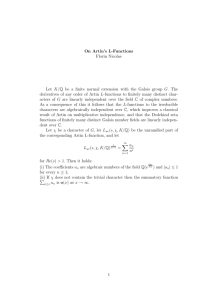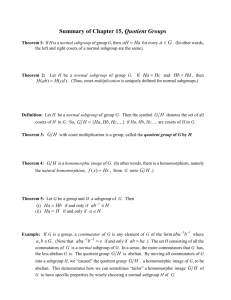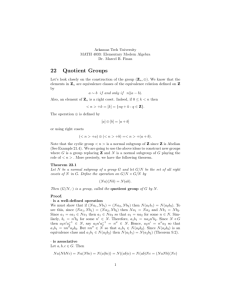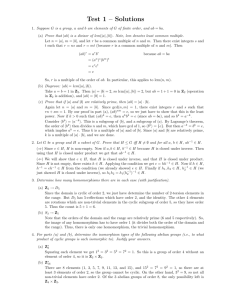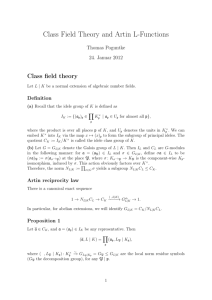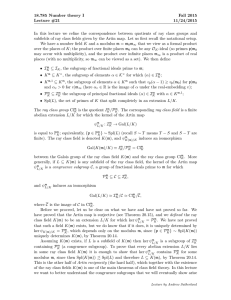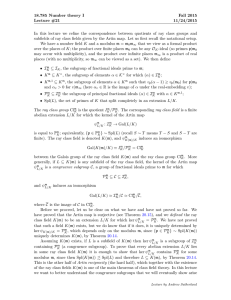MATH 254A: CLASS FIELD THEORY III 1. The main theorems
advertisement
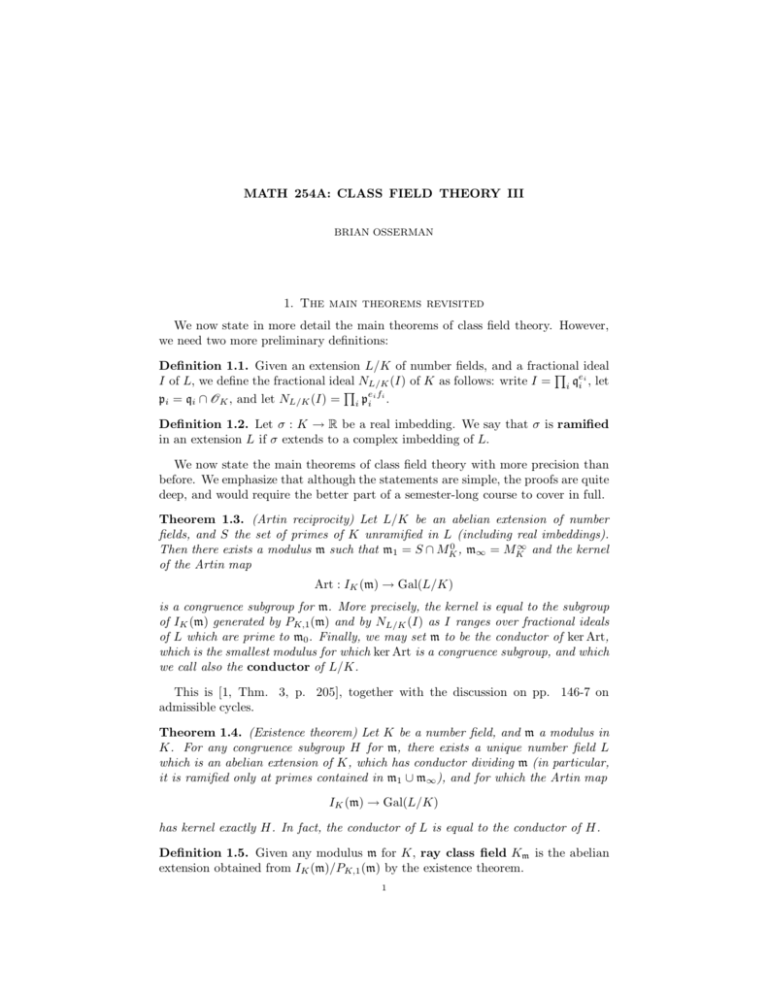
MATH 254A: CLASS FIELD THEORY III BRIAN OSSERMAN 1. The main theorems revisited We now state in more detail the main theorems of class field theory. However, we need two more preliminary definitions: Definition 1.1. Given an extension L/K of number fields, and a fractional Q ideal I of L, we define the fractional ideal NL/K (I) of K as follows: write I = i qei i , let Q pi = qi ∩ OK , and let NL/K (I) = i piei fi . Definition 1.2. Let σ : K → R be a real imbedding. We say that σ is ramified in an extension L if σ extends to a complex imbedding of L. We now state the main theorems of class field theory with more precision than before. We emphasize that although the statements are simple, the proofs are quite deep, and would require the better part of a semester-long course to cover in full. Theorem 1.3. (Artin reciprocity) Let L/K be an abelian extension of number fields, and S the set of primes of K unramified in L (including real imbeddings). 0 ∞ Then there exists a modulus m such that m1 = S ∩ MK , m∞ = MK and the kernel of the Artin map Art : IK (m) → Gal(L/K) is a congruence subgroup for m. More precisely, the kernel is equal to the subgroup of IK (m) generated by PK,1 (m) and by NL/K (I) as I ranges over fractional ideals of L which are prime to m0 . Finally, we may set m to be the conductor of ker Art, which is the smallest modulus for which ker Art is a congruence subgroup, and which we call also the conductor of L/K. This is [1, Thm. 3, p. 205], together with the discussion on pp. 146-7 on admissible cycles. Theorem 1.4. (Existence theorem) Let K be a number field, and m a modulus in K. For any congruence subgroup H for m, there exists a unique number field L which is an abelian extension of K, which has conductor dividing m (in particular, it is ramified only at primes contained in m1 ∪ m∞ ), and for which the Artin map IK (m) → Gal(L/K) has kernel exactly H. In fact, the conductor of L is equal to the conductor of H. Definition 1.5. Given any modulus m for K, ray class field Km is the abelian extension obtained from IK (m)/PK,1 (m) by the existence theorem. 1 2 BRIAN OSSERMAN 2. Partial orders Now we have seen that we can consider a congruence subgroup for a modulus m in terms of a modulus m′ with m|m′, without affecting the associated generalized ideal class group. We thus have a natural partial ordering on generalized ideal class groups, determined by whether there exists a common modulus in which one congruence subgroup is contained in the other. Of course, we also have the inclusion partial ordering on the collection of abelian extensions of a given number field, and we now see that the two partial orderings correspond to one another under the bijection obtained by class field theory. We have: Easy Fact 2.1. Let E/L/K be number fields, with E (and hence L) abelian over K. Then for any p ∈ K which is unramified in E, we have that FrL/K (p) is simply the restriction of FrE/K (p) to Gal(L/K). Corollary 2.2. Let E, L be finite abelian extensions of K. Then L ⊂ E if and only if there exists a modulus m in K such that ker Art for E and L, which we denote by HE and HL respectively, are congruence subgroups for m, and HE ⊂ HL. Moreover, it suffices to take m to be the least modulus divisible by the conductor of both fields, which will be the conductor of E if L ⊂ E. Proof. If L ⊂ E, we apply Artin reciprocity to obtain a modulus m such that HE is a congruence subgroup for m; Then, the easy fact and multiplicativity of the Artin map gives us that the Artin map for L is obtained by restricting the Artin map for E. So if I ∈ ker ArtE/K , then we must have I ∈ ker ArtL/K as well, and HE ⊂ HL ; in particular, HL is also a congruence subgroup for m. Conversely, given m as in the statement, let G be the image of HL under the Artin map for E over K, and let L̃ ⊂ E be the fixed field of G. We claim that ker ArtL/K = ker ArtL̃/K . Indeed, if I ∈ ker ArtL/K = HL , then ArtL̃/K (I) = ArtE/K (I)|L̃ ∈ G|L̃ = 1 by definition. Conversely, if I ∈ ker ArtL̃/K then by Galois theory ArtE/K (I) ∈ G = ArtE/K (HK ), so I ∈ HL + HE = HL because HE ⊂ HL by hypothesis. By the uniqueness in the existence theorem, it follows that L = L̃, and L ⊂ E. Corollary 2.3. Let S be a collection of moduli in K such that for any modulus m, there is a m′ ∈ S with m|m′ . Then every abelian extension is contained in a ray class field Km with m ∈ S. Proof. Let L be an abelian extension of K. By Artin reciprocity, there exists a modulus m for which ker ArtL/K is a congruence subgroup. Let m′ ∈ S be such that m|m′ ; then we have that ker ArtL/K for the modulus m′ is also a congruence subgroup, and necessarily contains PK,1 (m′ ). It follows from the previous corollary that L ⊂ Km′ . 3. Examples and applications Example 3.1. We consider the case of Q(ζn ) over Q. For notational simplicity, we assume that n 6≡ 2 (mod 4), since otherwise we could use Q(ζn/2 ) instead. Since Q is real and Q(ζn ) is complex, the infinite prime is ramified, so we will work with the modulus m = n∞. We know that for p prime to n, Fr(p) = [p] ∈ (Z/nZ)∗ ∼ = Gal(Q(ζn )/Q). Note that here we have chosen the positive generator of the ideal MATH 254A: CLASS FIELD THEORY III 3 (p). Thus, ArtQ(ζn )/Q ((x)) = [x] ∈ (ZZ/nZ)∗ if x is the positive generator of (x), and the kernel is precisely the set of principal ideals generated by x such that x ≡ 1 (mod n) and x > 0, which is the definition of PK,1 (m). Thus, we see that Q(ζn ) is the ray class field Qm . Putting the example together with the previous corollary, we immediately find: Theorem 3.2. (Kronecker-Weber) Every abelian extension of Q is contained in a cyclotomic extension. Of course, there are proofs of this theorem not requiring class field theory, but the fact that it falls out immediately as a special case of far more general results illustrates some of the power of the theory. We conclude by showing that quadratic reciprocity follows easily from Artin reciprocity, perhaps somewhat justifying the terminology. p−1 = pq , where ∗ = (−1) 2 . Theorem 3.3. We have ∗p q √ Proof. Consider the fields Q(ζp ) and Q( ∗p); by our earlier work on fixed fields √ of Dirichlet characters, we know that Q( ∗p) has discriminant ∗p and is therefore contained in Q(ζp ). We also know that Q(ζp ) is the ray class field for m = p∞. √ We consider the Artin map for Q( ∗p) and the modulus m. We see directly from , since the quadratic the definitions that evaluated on primes q, it is simply ∗p q √ character determines whether q splits in Q( ∗p). On the other hand, from class field theory the Artin map has kernel a congruence subgroup, and in particular containing PK,1 (m). Another way to say this is that for m, ArtQ(√∗p) factors through ArtQ(ζp ) , which factors through Gal(Q(ζp )/Q) ∼ = (Z/pZ)∗. Thus ArtQ(√∗p) induces a (non-trivial) map (Z/pZ)∗ to (±1), and since quadratic characters modulo p, we conclude that this map is pq . References 1. Serge Lang, Algebraic number theory, second ed., Springer-Verlag, 1994.


